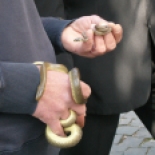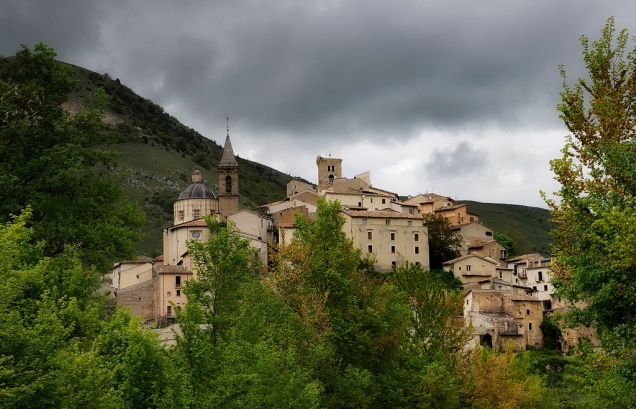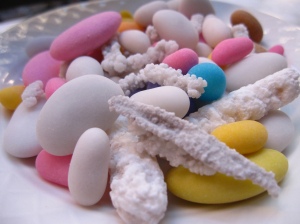In honor of National Lasagna Day in the United States (July 29th)!

Just looking at a picture of lasagna makes my stomach rumble! It ignites my savory cravings and when I eat it, rarely can I stop at just one serving. Made of sheets of pasta layered in a baking dish with different ingredients and sauces, the classic lasagna version hails from Bologna in the Emilia Romagna but the Naples version from Campania is just as famous. The variations are endless!

While traveling throughout Italy, I noticed that lasagne (Lasagna in Italian) is different than what I have experienced in your standard, run-of-the-mill Italian-American family restaurant. It’s probably closer to what you find when invited to the homes of friends and relatives of Italian descent. I prepare lasagna several times a year, typically when I have a large group for dinner at my home. (Friends, I reveal my secret recipe below!)

In 2011 my husband and I were dinner guests at the family home of our friend Andrea in Forli, Emilia Romagna. We had been traveling in Italy for several weeks and eaten some fine lasagne in restaurants. We were delighted when Mamma Pasini served up her personal lasagne recipe. In an attempt to determine why what we were tasting was so different than what I had encountered back home, I took the opportunity to ask about the ingredients (with Viviana translating). Mamma Pasini’s recipe differed in four key ways: it was light on tomatoes, had no ricotta, didn’t have as many layers of pasta sheets, and, perhaps most importantly, it was made with bechamel sauce. (Note: southern Italian recipes tend to be heavier on the tomatoes, so if they are a problem for you try a central/northern Italian recipe like the link below, instead).

Upon our return to States, I feverishly searched for a recipe I thought resembled what had been discussed in the kitchen back in Forli. (Que drumroll…) I zeroed in on one called “Giorgios Tuscan Lasagna” (see link below). So now my secret is out! The lasagna friends have been enjoying at my home for several years is a fantastic recipe I found online. Whether it’s a group of friends or family, lasagna is always a winner in my book – Happy National Lasagna Day USA!
LASAGNA FESTIVALS
To sample Lasagnas from different regions of Italy, attend one of these festivals dedicated to Lasagna throughout Italy:
May – Oricola, Abruzzo
May – Montenero d’Orica, Tuscany
May/June – Arci di San Lazzaro, Bologna, Emilia Romagna
June/July – Bosio, Piemonte
August – Mercato San Severino, Salerno, Campania Lasagna & Meatballs Festival!
NOTE: dates/months may change each year – always confirm!
TIP: To find your own, search on “Sagra della Lasagna”
#NationalLasagnaDay #lasagna #lasagne #italyfestivals #italianfood
INFORMATION
Giorgios Tuscan Lasagna by Squirrel_Nut from Austin, TX
ABOUT
Lisa M. Vogele is the author of Food & Folklore: A Year of Italian Festivals, a travel reference guide that “helps you go local” by incorporating festivals into your travel planning. The second book in her Food & Folklore Series on Festivals of Spain will hit the shelves in 2017. You can find out more information about Lisa’s books, travel services, custom itineraries, and small group tours at Lisa’s Travel Guides or lisa@lisastravelguides.com
BROCHURE: Fun with Food & Festivals Tours!








 ABOUT
ABOUT



 The snake handlers (serpari) start gathering them in March for the May celebration. The snakes used to be housed in clay pots but are now kept in wooden boxes and fed mice and hardboiled eggs in the days leading up to the festival. There are four types of non-venomous snakes used in the procession. The statue with the snakes and its escorts are accompanied by two women dressed in traditional costumes carrying breadbaskets on their head that contain five ciambellati. Ciambellati are local, sweet, round breads that have been blessed by the parish priest and given to the escorts carrying the statue in the procession.
The snake handlers (serpari) start gathering them in March for the May celebration. The snakes used to be housed in clay pots but are now kept in wooden boxes and fed mice and hardboiled eggs in the days leading up to the festival. There are four types of non-venomous snakes used in the procession. The statue with the snakes and its escorts are accompanied by two women dressed in traditional costumes carrying breadbaskets on their head that contain five ciambellati. Ciambellati are local, sweet, round breads that have been blessed by the parish priest and given to the escorts carrying the statue in the procession. Stands are set up around town to feed the thousands that have descended on the town for the spectacle. There is a fireworks display at the conclusion of the festival. Parking is quite difficult so expect to walk or be shuttled from wherever you park to the edge of town.
Stands are set up around town to feed the thousands that have descended on the town for the spectacle. There is a fireworks display at the conclusion of the festival. Parking is quite difficult so expect to walk or be shuttled from wherever you park to the edge of town.


